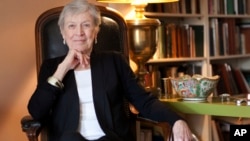Paula Fox, a prize-winning author who created high art out of imagined chaos in such novels as Poor George and Desperate Characters and out of the real-life upheavals in her memoir Borrowed Finery, has died at age 93.
Her daughter, Linda Carroll, told The Associated Press that Fox died Wednesday at Brooklyn Methodist Hospital. She had been in failing health.
Abandoned as a girl by her parents, a single mother before age 20, Fox used finely crafted prose to write again and again about breakdown and disruption, what happens under the “surface of things.” In Poor George, her debut novel, Fox told of a bored schoolteacher and the teen vagrant who upends his life. Desperate Characters, her most highly regarded work of fiction, is a portrait of New York City’s civic and domestic decline in the 1960s, a plague symbolized by the bite of a stray cat.
“It seems to me that in life, behind all these names and things and people and forces, there’s a dark energy,” Fox told The Associated Press in 2011.
Late-life revival
Her work was out of print for years, but she enjoyed a late-life revival thanks to the admiration of such younger authors as Jonathan Franzen, David Foster Wallace and Jonathan Lethem. She lived for decades in Brooklyn and was a revered figure in the New York City borough’s thriving literary community.
Her other books included the novels A Servant’s Tale, The Western Coast and a memoir about living in Europe after World War II, The Coldest Winter. Fox also wrote more than a dozen children’s books, including The Slave Dancer, winner of the Newbery medal in 1974. Borrowed Finery, published in 2001, was nominated for the National Book Critics Circle award.
She might have written more novels, but a head injury sustained from a mugging in Jerusalem in the 1990s left her unable to write long fiction. She instead began working on memoirs and shorter pieces.
Difficult childhood
Born in New York City in 1923, Fox was the daughter of novelist-screenwriter Paul Fox and fellow screenwriter Elsie Fox. Paula Fox remembered her father as a drunk given to “interminable, stumbling descriptions of the ways in which he and fellow writers tried to elude domesticity.” Her mother was a “sociopath” who kicked her out of the house as a young girl. Fox lived everywhere from a plantation in Cuba to a boarding school in Montreal.
Living in Hollywood in the 1930s and ’40s, she danced with John Wayne and encountered John Barrymore, “yellowing with age like the ivory keys of a very old piano.” Marlon Brando was a friend, and Courtney Love is her granddaughter, born to Carroll, whom a 19-year-old Fox gave up for adoption. Her brother-in-law, Clement Greenberg, was among the 20th century’s most influential art critics.
Although a devoted reader since childhood, she didn’t publish until past 40. She worked for years as a teacher and as a tutor for troubled children and was married briefly for a second time, to Richard Sigerson, with whom she had two sons. She finally settled down with her third husband, translator and Commentary editor Martin Greenberg, whom she met after he had rejected a story she submitted for the magazine.









